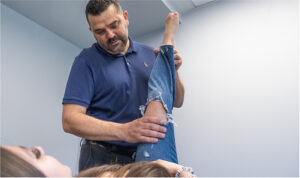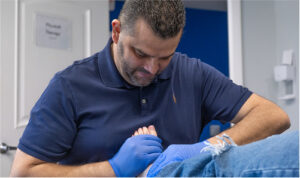Overview
Leg pain is a common issue that can affect mobility, daily activities, and overall quality of life. It can stem from muscle strain, nerve compression, joint conditions, or circulation problems. People experiencing constant leg pain, numbness, weakness, or swelling should seek medical attention promptly.
Symptoms of Leg Pain
- Aching, sharp, or burning pain in the legs.
- Pain that worsens with movement or prolonged standing.
- Muscle cramps or spasms.
- Numbness, tingling, or weakness in the legs.
- Swelling or tenderness in the affected area.
What Causes Leg Pain?
Leg pain can result from a variety of musculoskeletal, neurological, and vascular conditions. Common causes include:
Muscle strain: Overuse, improper exercise techniques, or sudden movements can strain muscles.
Nerve compression: Conditions such as sciatica or herniated discs can put pressure on nerves, leading to radiating leg pain.
Joint issues: Arthritis, bursitis, or hip and knee joint degeneration can contribute to leg discomfort.
Circulatory problems: Poor blood circulation, deep vein thrombosis (DVT), or varicose veins can cause leg pain and swelling.
Injuries: Sports injuries, fractures, or ligament sprains can lead to acute or chronic leg pain.
Underlying medical conditions: Diabetes, peripheral neuropathy, or vascular diseases may result in chronic leg pain.
Preventing Leg Pain
Preventing leg pain involves maintaining mobility, strengthening muscles, and improving circulation. Consider these strategies:
- Maintain proper posture. Keep weight evenly distributed while standing and walking.
- Stretch regularly. Gentle stretching can improve flexibility and reduce muscle tension.
- Wear supportive footwear. Proper shoes can help align the body and reduce strain on the legs.
- Stay active. Low-impact exercises such as walking, swimming, and cycling can promote leg health.
- Hydrate and maintain a balanced diet. Proper nutrition supports muscle and joint function.
- Avoid prolonged sitting or standing. Frequent movement helps prevent stiffness and circulatory issues.
How Physical Therapy Can Help
Physical therapy plays a crucial role in addressing leg pain by improving strength, flexibility, and circulation while reducing discomfort. Common physical therapy treatments include:
- Manual therapy to relieve muscle tension and improve joint mobility.
- Strength training to support the lower body and enhance stability.
- Stretching and flexibility exercises to promote better range of motion.
- Gait training to improve walking patterns and reduce strain on the legs.
- Pain management techniques such as heat, ice, and electrical stimulation.
- Neuromuscular re-education to restore normal movement patterns and prevent injury.
Request an Appointment
If you are experiencing persistent or worsening neck pain, physical therapy may provide effective relief. Contact Us today to receive a personalized treatment plan tailored to your condition.


